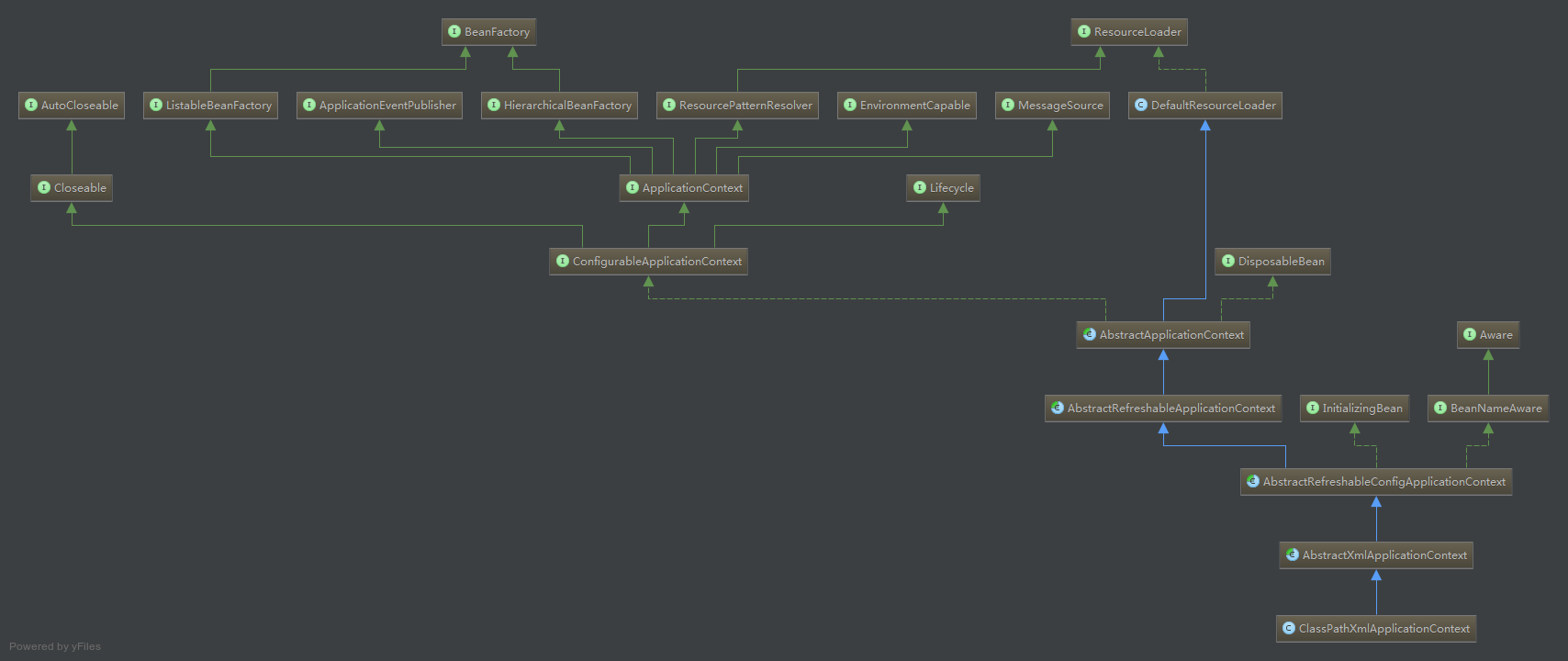spring啟動加載過程源碼分析
我們知道啟動spring容器兩常見的兩種方式(其實都是加載spring容器的xml配置文件時啟動的):
1.在應用程序下加載
ApplicationContext ctx = new ClassPathXmlApplicationContext("spring-context.xml");
2.web模式下加載
<context-param> <param-name>contextConfigLocation</param-name> <param-value>classpath:spring-context.xml</param-value> </context-param> <listener> <listener-class>org.springframework.web.context.ContextLoaderListener</listener-class> </listener>
可以發現,執行new ClassPathXmlApplicationContext()的時候會打印以下日誌:
2017-5-15 12:48:48 org.springframework.context.support.AbstractApplicationContext prepareRefresh
即調用AbstractApplicationContext類的prepareRefresh方法,我們去看AbstractApplicationContext類:
通過類圖可以發現AbstractApplicationContext是一個抽象類,也屬於BeanFactory體系,實現了ApplicationContext,再往下找到他的子類ClassPathXmlApplicationContext,來看它的具體實現
類裏有很多重載的構造函數,到最後都是調用這個:
public ClassPathXmlApplicationContext(String[] paths, Class clazz, ApplicationContext parent)throws BeansException { super(parent); Assert.notNull(paths, "Path array must not be null"); Assert.notNull(clazz, "Class argument must not be null"); this.configResources = new Resource[paths.length]; for (int i = 0; i < paths.length; i++) { this.configResources[i] = new ClassPathResource(paths[i], clazz); }
//IOC初始化過程 refresh(); }
這裏就到重點了,refresh方法定義了ioc容器啟動的整個過程,來看源碼
public void refresh() throws BeansException, IllegalStateException { synchronized (this.startupShutdownMonitor) { // 1.Prepare this context for refreshing. prepareRefresh(); // 2.Tell the subclass to refresh the internal bean factory. ConfigurableListableBeanFactory beanFactory = obtainFreshBeanFactory(); // 3.Prepare the bean factory for use in this context. prepareBeanFactory(beanFactory); try { 4.// Allows post-processing of the bean factory in context subclasses. postProcessBeanFactory(beanFactory); 5.// Invoke factory processors registered as beans in the context. invokeBeanFactoryPostProcessors(beanFactory); 6.// Register bean processors that intercept bean creation. registerBeanPostProcessors(beanFactory); 7.// Initialize message source for this context. initMessageSource(); 8.// Initialize event multicaster for this context. initApplicationEventMulticaster(); 9.// Initialize other special beans in specific context subclasses. onRefresh(); 10.// Check for listener beans and register them. registerListeners(); 11.// Instantiate all remaining (non-lazy-init) singletons. finishBeanFactoryInitialization(beanFactory); //12. Last step: publish corresponding event. finishRefresh(); } catch (BeansException ex) { // 13.Destroy already created singletons to avoid dangling resources. destroyBeans(); // 14.Reset ‘active‘ flag. cancelRefresh(ex); // 15.Propagate exception to caller. throw ex; } } }
接下來,一步一步分析spring幹了哪些事
1.初始化BeanFactory:根據配置文件實例化BeanFactory,getBeanFactory()方法由具體子類實現。在這一步裏,Spring將配置文件的信息解析成為一個個的BeanDefinition對象並裝入到容器的Bean定義註冊表(BeanDefinitionRegistry)中,但此時Bean還未初始化;obtainFreshBeanFactory()會調用自身的refreshBeanFactory(),而refreshBeanFactory()方法由子類AbstractRefreshableApplicationContext實現,該方法返回了一個創建的DefaultListableBeanFactory對象,這個對象就是由ApplicationContext管理的BeanFactory容器對象。這一步的操作相當於,如果我們在自己的應用代碼中不用ApplicationContext而直接用BeanFactory時創建BeanFactory對象的操作,核心代碼如下:
reader.loadBeanDefinitions(configLocations);
2.調用工廠後處理器,根據反射機制從BeanDefinitionRegistry中找出所有BeanFactoryPostProcessor類型的Bean,並調用其postProcessBeanFactory()接口方法。經過第一步加載配置文件,已經把配置文件中定義的所有bean裝載到BeanDefinitionRegistry這個Beanfactory中,對於ApplicationContext應用來說這個BeanDefinitionRegistry類型的BeanFactory就是Spring默認的DefaultListableBeanFactory
public class DefaultListableBeanFactory extends AbstractAutowireCapableBeanFactory implements ConfigurableListableBeanFactory, BeanDefinitionRegistry{}
在這些被裝載的bean中,若有類型為BeanFactoryPostProcessor的bean(配置文件中配置的),則將對應的BeanDefinition生成BeanFactoryPostProcessor對象容器掃描BeanDefinitionRegistry中的BeanDefinition,使用java反射自動識別出Bean工廠後處理器(實現BeanFactoryPostProcessor接口)的bean,然後調用這些bean工廠後處理器對BeanDefinitionRegistry中的BeanDefinition進行加工處理,可以完成以下兩項工作(當然也可以有其他的操作,用戶自己定義):
1).對使用到占位符的<bean>元素標簽進行解析,得到最終的配置值,這意味著對一些半成品式的BeanDefinition對象進行加工處理並取得成品的BeanDefinition對象。
2).對BeanDefinitionRegistry中的BeanDefinition進行掃描,通過Java反射機制找出所有屬性編輯器的Bean(實現java.beans.PropertyEditor接口的Bean),並自動將它們註冊到Spring容器的屬性編輯器註冊表中(PropertyEditorRegistry),這個Spring提供了實現:CustomEditorConfigurer,它實現了BeanFactoryPostProcessor,用它來在此註冊自定義屬性編輯器,核心代碼如下:
protected void invokeBeanFactoryPostProcessors(ConfigurableListableBeanFactory beanFactory) { // Invoke factory processors registered with the context instance. for (Iterator it = getBeanFactoryPostProcessors().iterator(); it.hasNext();) { BeanFactoryPostProcessor factoryProcessor = (BeanFactoryPostProcessor) it.next(); factoryProcessor.postProcessBeanFactory(beanFactory); } // Do not initialize FactoryBeans here: We need to leave all regular beans // 通過ApplicatinContext管理的beanfactory獲取已經註冊的BeanFactoryPostProcessor類型的bean的名字 String[] factoryProcessorNames = beanFactory.getBeanNamesForType(BeanFactoryPostProcessor.class, true, false); // Separate between BeanFactoryPostProcessors that implement the Ordered // interface and those that do not. List orderedFactoryProcessors = new ArrayList(); List nonOrderedFactoryProcessorNames = new ArrayList(); for (int i = 0; i < factoryProcessorNames.length; i++) { if (isTypeMatch(factoryProcessorNames[i], Ordered.class)) { // 調用beanfactory的getBean取得所有的BeanFactoryPostProcessor對象 orderedFactoryProcessors.add(beanFactory.getBean(factoryProcessorNames[i])); } else { nonOrderedFactoryProcessorNames.add(factoryProcessorNames[i]); } } // First, invoke the BeanFactoryPostProcessors that implement Ordered. Collections.sort(orderedFactoryProcessors, new OrderComparator()); for (Iterator it = orderedFactoryProcessors.iterator(); it.hasNext();) { BeanFactoryPostProcessor factoryProcessor = (BeanFactoryPostProcessor) it.next(); // 執行BeanFactoryPostProcessor的方法,傳入當前持有的beanfactory對象,以獲取要操作的 // BeanDefinition factoryProcessor.postProcessBeanFactory(beanFactory); } // Second, invoke all other BeanFactoryPostProcessors, one by one. for (Iterator it = nonOrderedFactoryProcessorNames.iterator(); it.hasNext();) { String factoryProcessorName = (String) it.next(); ((BeanFactoryPostProcessor) getBean(factoryProcessorName)). postProcessBeanFactory(beanFactory); } }
BeanFactoryPostProcessor接口代碼如下,實際的操作由用戶擴展並配置:
public interface BeanFactoryPostProcessor { /** * Modify the application context‘s internal bean factory after its standard */ void postProcessBeanFactory(ConfigurableListableBeanFactory beanFactory) throws BeansException; }
3.註冊Bean後處理器,根據反射機制從BeanDefinitionRegistry中找出所有BeanPostProcessor類型的Bean,並將它們註冊到容器Bean後處理器的註冊表中,AbstractApplicatinContext中對應代碼如下:
protected void registerBeanPostProcessors(ConfigurableListableBeanFactory beanFactory) { String[] processorNames = beanFactory.getBeanNamesForType(BeanPostProcessor.class, true, false); // Register BeanPostProcessorChecker that logs an info message when int beanProcessorTargetCount = beanFactory.getBeanPostProcessorCount() + 1 + processorNames.length; beanFactory.addBeanPostProcessor(new BeanPostProcessorChecker(beanFactory, beanProcessorTargetCount)); List orderedProcessors = new ArrayList(); List nonOrderedProcessorNames = new ArrayList(); for (int i = 0; i < processorNames.length; i++) { if (isTypeMatch(processorNames[i], Ordered.class)) { orderedProcessors.add(getBean(processorNames[i])); } else { nonOrderedProcessorNames.add(processorNames[i]); } } // First, register the BeanPostProcessors that implement Ordered. Collections.sort(orderedProcessors, new OrderComparator()); for (Iterator it = orderedProcessors.iterator(); it.hasNext();) { // 註冊bean後處理器,該方法定義於ConfigurableBeanFactory接口 beanFactory.addBeanPostProcessor((BeanPostProcessor) it.next()); } // Second, register all other BeanPostProcessors, one by one. for (Iterator it = nonOrderedProcessorNames.iterator(); it.hasNext();) { String processorName = (String) it.next(); beanFactory.addBeanPostProcessor((BeanPostProcessor) getBean(processorName)); } }
整段代碼類似於第三步的調用工廠後處理器,區別之處在於,工廠後處理器在獲取後立即調用,而Bean後處理器在獲取後註冊到上下文持有的beanfactory中,供以後操作調用(在用戶獲取bean的過程中,對已經完成屬性設置工作的Bean進行後續加工,他加工的是bean,而工廠後處理器加工的是BeanDefinition)BeanPostProcessor 接口代碼如下,實際的操作由用戶擴展並配置:
public interface BeanPostProcessor { Object postProcessBeforeInitialization(Object bean, String beanName) throws BeansException; Object postProcessAfterInitialization(Object bean, String beanName) throws BeansException; }
4.初始化消息源,初始化容器的國際化信息資源,源代碼如下:
protected void initMessageSource() { // 具體實現 }
5.初始化應用上下文事件廣播器;(觀察者模式中的具體主題角色,持有觀察者角色的集合,稱為註冊表)AbstractApplciationContext擁有一個applicationEventMulticaster 成員變量,applicationEventMulticaster 提供了容器監聽器的註冊表,成其為事件廣播器。在第七步中將會將事件監聽器裝入其中,AbstractApplicationContext中的代碼如下:
protected void initApplicationEventMulticaster() { // "applicationEventMulticaster",先看配置文件中有無配置該類型類(用戶擴展 擴展點,如何擴展) if (containsLocalBean(APPLICATION_EVENT_MULTICASTER_BEAN_NAME)) { this.applicationEventMulticaster = (ApplicationEventMulticaster) getBean(APPLICATION_EVENT_MULTICASTER_BEAN_NAME, ApplicationEventMulticaster.class); } else { // 若沒有,則應用Spring框架提供的事件廣播器實例 this.applicationEventMulticaster = new SimpleApplicationEventMulticaster(); } } public boolean containsLocalBean(String name) { return getBeanFactory().containsLocalBean(name); } public Object getBean(String name, Class requiredType) throws BeansException { return getBeanFactory().getBean(name, requiredType); }
Spring初始化事件廣播器,用戶可以在配置文件中為容器定義一個自定義的事件廣播器(bean的名稱要為"applicationEventMulticaster"),只要實現ApplicationEventMulticaster就可以了,Spring在此會根據beanfactory自動獲取。如果沒有找到外部配置的事件廣播器,Spring使用SimpleApplicationEventMulticaster作為事件廣播器。
6.初始化其他特殊的Bean:這是一個鉤子方法,子類可以借助這個鉤子方法執行一些特殊的操作,如AbstractRefreshableWebApplicationContext就使用該鉤子方法執行初始化ThemeSource的操作;
protected void onRefresh() throws BeansException { // For subclasses: do nothing by default. }
7.註冊事件監聽器;(觀察者模式中的觀察者角色)
Spring根據上下文持有的beanfactory對象,從它的BeanDefinitionRegistry中找出所有實現org.springfamework.context.ApplicationListener的bean,將BeanDefinition對象生成bean,註冊為容器的事件監聽器,實際的操作就是將其添加到事件廣播器所提供的監聽器註冊表中
AbstractApplicationContext中的代碼如下:
/** Statically specified listeners */ private List applicationListeners = new ArrayList(); public List getApplicationListeners() { return this.applicationListeners; } protected void registerListeners() { // Register statically specified listeners first. for (Iterator it = getApplicationListeners().iterator(); it.hasNext();) { addListener((ApplicationListener) it.next()); } // 獲取ApplicationListener類型的所有bean,即事件監聽器 // uninitialized to let post-processors apply to them! Collection listenerBeans = getBeansOfType(ApplicationListener.class, true, false).values(); for (Iterator it = listenerBeans.iterator(); it.hasNext();) { // 將事件監聽器裝入第五步初始化的事件廣播器 addListener((ApplicationListener) it.next()); } } public Map getBeansOfType(Class type, boolean includePrototypes, boolean allowEagerInit) throws BeansException { return getBeanFactory().getBeansOfType(type, includePrototypes, allowEagerInit); } protected void addListener(ApplicationListener listener) { getApplicationEventMulticaster().addApplicationListener(listener); }
ApplicationListener 的源代碼如下:
/** * Interface to be implemented by application event listeners. * @see org.springframework.context.event.ApplicationEventMulticaster */ public interface ApplicationListener extends EventListener { void onApplicationEvent(ApplicationEvent event); }
8.初始化singleton的Bean:實例化所有singleton的Bean,並將它們放入Spring容器的緩存中;這就是和直接在應用中使用BeanFactory的區別之處,在創建ApplicationContext對象時,不僅創建了一個BeanFactory對象,並且還應用它實例化所有單實例的bean。(在spring的配置文件中,bean默認為單例,除非在bean的配置中顯式指定scope="prototype")
AbstractApplicationContext中的代碼如下:
beanFactory.preInstantiateSingletons();
9.發布上下文刷新事件:在此處時容器已經啟動完成,發布容器refresh事件(ContextRefreshedEvent)
創建上下文刷新事件,事件廣播器負責將些事件廣播到每個註冊的事件監聽器中。
publishEvent(new ContextRefreshedEvent(this)); public void publishEvent(ApplicationEvent event) { Assert.notNull(event, "Event must not be null"); // 在此獲取事件廣播器,並調用其方法發布事件:調用所有註冊的監聽器的方法 getApplicationEventMulticaster().multicastEvent(event); if (this.parent != null) { this.parent.publishEvent(event); } }
至此,ApplicationContext對象就完成了初始化工作:創建BeanFactory來裝配BeanDefiniton,加工處理BeanDefiniton,註冊了bean後處理器,初始化了消息資源,初始化了應用上下文事件廣播器,註冊了事件監聽器,初始化了所有singleton的bean,最後發布上下文刷新事件。
spring啟動加載過程源碼分析
